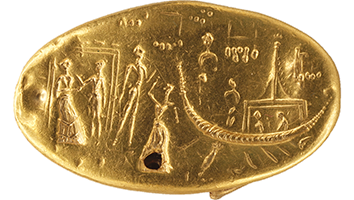Flat hull with curving extremities, the one on the right being somewhat higher. The hull is decorated with a zigzag line.
Minoan ship blessing
A186
LM IB (ca. 1450 B.C.)
Poros
Bezel: L: 2.0 cm; W: 1.0 cm; Th.: 0.3 cm; Hoop: 1.28 x 1.37 cm; W: 0.3 cm; Th.: 0.13 cm; weight: 4.1 gm
Gold ring with hollow oval bezel constructed with finger-bed plate. Hoop of semi-circular profile with transverse ribbing, each rib having a lengthwise central groove. Hoop bent out of shape and broken away from the bezel at the top. Engraved and punched, engraving is very sharp and fresh.
Alexiou 1958; Boulotis 1989: 65-66, n. 13; CMS VI, Kat.Nr. 280; Evans 1928: 250, fig. 147b; Kyriakidis 2005: 138-139, 142, 152, fig. 2c; Niemeier 1989: pl. 2, fig; Rethemiotakis 2016/2017: 9, fig. 10; Vanschoonwinkel 1982: 34-35; Wedde 2000: 339, no. 902; Wingerath 1995: 200, no. 276
A couple on the left side of the seal faces a ship. The woman wears a flounced skirt, her head slightly inclined towards the man while her left arm is bent and held across her waist. To her right is a man, his left hand outstretched in the direction of the boat or alternative, the floating figure in the sky before him, while his right hand possibly holds her hand. Inside the boat on the left side stands a steersman facing the couple and holding a steering oar or pole. Behind him are seven oarsmen depicted in a schematic manner, also facing left. There is possibly a seated figure at the right end of the boat. Floating in the air above the boat is a small figure in a short bell-shaped garment, their left arm bent while the right arm is outstretched towards the man. Three dolphins leap to the right below the ship. Additional objects include an oval object with a flat top behind the woman, as well as a floating tree behind the floating figure.
The likelihood that the ring originates from the harbour town of Knossos (Poros) is reinforced by three other securely provenanced signet rings acquired through excavation which all share important similarities in their iconographic content, namely the depiction of a divine couple. These also provide a LM IB date for the ring, since the other three examples come from burials in the final phase of the cemetery’s use during LM IB (Rethemiotakis 2016/2017: 9-11).
According to Rethemiotakis, the four gold rings from Poros depict the visualized epiphany and encounter of two deities in an iconographically and symbolically related manner, showing different stages of their journey from the mountains and meadows to the seashore. These themes were likely drawn from the iconographic program of the Palace of Knossos and held a special semiotic value for a distinct social group residing at Poros, outlining the extent of divine protection stretching over nature and the sea in its entirety. Connecting the entire narrative to A186, Rethemiotakis concludes as follows: “depicted as travelling under the protective hand of the god, the boat of the Oxford ring might reflect in reality a request for protection on the sea and trade routes for those departing from the large Minoan harbour of Poros. This could in the long run have been the one and only aim: to demonstrate forcefully through a well-constructed and complex religious formula the vital role of the land and the sea in maintaining and expanding the Minoan maritime state.” (Ibid: 11).
Small floating or suspended figures have been generally interpreted as representing the presence or manifestation of a deity, ie divine epiphanies, with the deity presenting him or herself to the other characters of the scene. Kyriakidis has made the intriguing argument that the floating objects represent constellations, pointing that there are good correspondences based on both their physical resemblance and relative position to each other. The floating female figure of A186 is identified as Bootes and her hair as Corona Borealis, which is attested from three other rings where the figure shares the same common stance (Kyriakidis 2005: 138-139, 152). His analysis is based on the observation that floating objects maintain the same basic form and direction, in addition to having a stable composition to one another when they are repeated in combination (Ibid: 142-143). This pattern furthermore extends to floating figures, indicating that they belong to the same broad group of floating objects (Ibid: 145). Kyriakidis also suggests that these constellations may have been used to convey the period of the year during which the specific ritual events portrayed took place.
Alexiou, S. 1958. “'Oδαχτύλιος τής Oξφόρδης,” in G. Ernst (ed.) Minoica. Festschrift zum 80. Geburtstag von Johannes Sundwall. Berlin, pp. 1-5.
Boulotis, C. 1989. "La déesse minoenne à la rame-gouvernail," in in H. Tzalas (ed.) TROPIS I: 1st International Symposium on Ship Construction in Antiquity. Piraeus, 30 August – 1 September 1985. Piraeus: Hellenic Institute for the Preservation of Nautical Tradition, pp. 55-73.
Evans, A. J. 1928. The Palace of Minos. Vol II. London: Macmillan.
Hughes-Brock, H. and J. Boardman. 2009. Corpus der minoischen und mykenischen Siegel. Band VI. Oxford. The Ashmolean Museum. Mainz: Philipp von Zabern.
Kyriakidis, E. 2005. “Unidentified Floating Objects on Minoan Seals,” AJA 109.2: 137-154.
Niemeier, W.-D. 1989. "Zur Ikonographie von Gottheiten und Adoranten in den Kultszenen auf minoischen und mykenischen Siegein." In W. Miller (ed.) Fragen und Probeleme der bronzezeitlichen digischen Glyptik. CMS Suppl. 3. Berlin: Mann, pp. 163-86.
Rethemiotakis, G. 2016/2017. “The ›Divine Couple‹ ring from Poros and the origins of the Minoan calendar,” Mitteilungen des Deutschen Archaologischen Instituts - Athenische Abteilung 131-132: 1–29.
Vanschoonwinkel, J. 1982. “La barque dans le culte et la religion créto-mycéniens,” Revues des Archéologiques et Historiens d’Art de Louvain 15: 20-56.
Wedde, M. 2000. Towards a Hermeneutics of Aegean Bronze Age Ship Imagery. Peleus Studien zur Archäologie und Geschichte Griechenlands und Zyperns, vol. 6. Bibliopolis: Mannheim and Möhnsee.
Wingerath, H. 1995. Studien zur Darstellung des Menschen in der minoischen Kunst der älterenund jüngeren Palastzeit. Marburg: Tectum Verlag.





